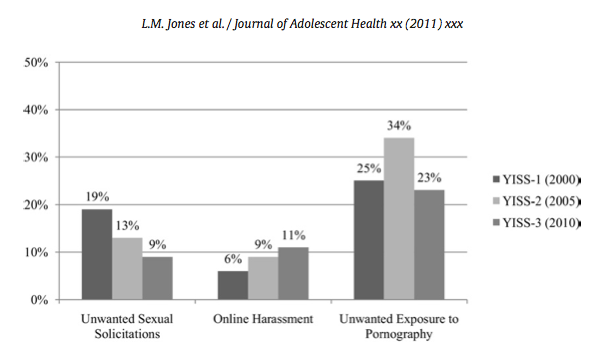Rise in social media correlates with safer experiences for teens
Here’s a shocker for some. By two important measures, teens are safer online now than they were before the advent of social media.
A new report, “Trends in Youth Internet Victimization: Findings From Three Youth Internet Safety Surveys 2000 –2010,” (PDF) from the Crimes against Children Research Center (CCRC) found a decline in 2010 of both unwanted sexual solicitations and unwanted exposure to pornography compared to studies conducted in 2005 and 2000. 95% of all teens ages 12-17 are now online and 80% of those online teens are users of social media sites
According to a 2011 report from the Pew Internet & American Life Project, “95% of all teens ages 12-17 are now online and 80% of those online teens are users of social media sites.”
As I wrote in my CNET News blog, a 2010 survey of 1,500 youth between 12 and 17 found that 9% had received an unwanted sexual solicitation in the past year. This compares to 13% in 2005 and 19% in 2000. In all three studies, some of those unwanted sexual solicitations came from other youth and the vast majority of them were not “aggressive.” Only 3% of the youth in 2010 said that offline contact was attempted or made. Most youth did not find the solicitations to be frightening or disturbing. That’s actually a bit lower than the 4% who had aggressive solicitations in 2005 and identical to the 2000 figure.
Small increase in online harassment
There was a small rise in the percentage of youth who experienced some type of online harassment during the 12 months preceding the survey. Eleven percent had experienced harassment in 2010 compared to 9% in 2005 and 6% in 2000.
Although sometimes used to indicate cyberbullying, harassment is not the same as bullying. The survey asked youth “did you ever feel worried or threatened because someone was bothering or harassing you online.” Bullying (cyber and otherwise) is defined by the Olweus Bullying Prevention program and most other experts as “aggressive behavior that involves unwanted, negative actions”along with “a pattern of behavior repeated over time” that “involves an imbalance of power or strength.”
Rise in social media
The mostly good news comes at a time when the majority of American youth are using social media, most notably Facebook. The first survey took place years before Facebook or MySpace, and the 2005 study before most teens were using Facebook (Facebook wasn’t open to high school students until September, 2005). Correlation doesn’t necessarily imply causation so I’m not suggesting that Facebook has necessary caused unwanted solicitation or pornography to decline. But it obviously hasn’t caused it to increase.
Could social networking be diverting kids from more dangerous sites?
I’m speculating, but I do wonder though whether a case could be made that social media has made kids safer and less prone to unwanted pornography. For one thing, kids are now spending time in sites like Facebook instead of chat rooms which were always the most problematic venue for unwanted solicitation. And, Facebook and most other social networking sites prohibit nudity and other sexually explicit content so, while kids are on Facebook they are very unlikely to stumble into pornography. Again, I don’t have data to support this but it sure seems likely.
The authors of the study made the same observation, pointing out that “youth have migrated from chat rooms to social networking sites over past several years. In social networking environments, youth may be confining more of their interactions to people they know, thus reducing online unwanted sexual comments or requests.”
Disclsoure: Larry Magid is co-director of ConnectSafely.org, a non-profit Internet safety organization that receives financial support from Facebook, Google, Tagged and other social media companies.

Leave a comment
You must be logged in to post a comment.